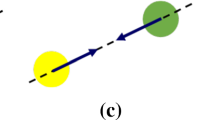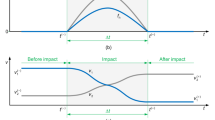Abstract
The increasing demand for real-time high-fidelity multibody dynamics simulations in several modern fields such as robotics and computer game industries has motivated many researches to propose novel approaches to model multibody systems with several contacts. The possibility of different contact conditions in a system with several contacts yields a combinatorial problem of potentially large size. Rigid contact model which is the most common model used for real-time simulations yields a non-smooth dynamic formulation. The solution of such a system can be governed using different methods. In this paper a comparison between the complementarity approaches and the augmented Lagrangian based formulations to deal with non-smooth contact models is presented via numerical examples, and the advantages and shortcomings of each method are discussed.









Similar content being viewed by others
Abbreviations
- \(\mathbf{q}\) :
-
generalized coordinate vector
- \(\mathbf{q}_{M}\) :
-
generalized coordinate vector at the midpoint of the time step
- \(\mathbf{q}_{A}\) :
-
generalized coordinate vector at the beginning of the time step
- \(\mathbf{q}_{E}\) :
-
generalized coordinate vector at the end of the time step
- \(\mathbf{M}\) :
-
system mass matrix
- \(t\) :
-
time
- \(\lambda_{N}\) :
-
normal contact force
- \(\lambda_{T}\) :
-
tangential contact force
- \(\mathbf{W}_{N}\) :
-
normal contact force direction vector
- \(\mathbf{W}_{T}\) :
-
tangential contact force direction vector
- \(P_{N}\) :
-
non-smooth potential
- \(\mathbf{h}\) :
-
vector containing all smooth forces and Coriolis acceleration
- \(g_{N}\) :
-
gap function at the contact
- \(\gamma_{T}\) :
-
tangential relative velocity of contacting surfaces
- \(\mu \) :
-
friction coefficient
- \(\mathbf{r}_{u}\) :
-
vector containing regularization factors for unilateral constraints
- \(\mathbf{r}_{b}\) :
-
vector containing regularization factor for bilateral constraints
- \(\mathbf{r}_{T}\) :
-
vector containing regularization factor for tangential constraints
- \(\varLambda \) :
-
contact impulses vector
- \(\mathbf{u}_{E}\) :
-
velocity vector at the end of the time-step
- \(\mathbf{u}_{A}\) :
-
velocity vector at the beginning of the time-step
References
Curnier, A., Alart, P.: A generalized Newton method for contact problems with friction. J. Méc. Théor. Appl. 67–82 (1988). Special issue entitled “Numerical Methods in Mechanics of Contact involving Friction”
Wittenburg, J.: Dynamics of Systems of Rigid Bodies. Teubner, Stuttgart (1977)
Huston, R.L.: Multibody Dynamics. Butterworth–Heinemann, Boston (1990)
Nikravesh, P.E.: Computer-Aided Analysis of Mechanical Systems. Prentice-Hall, Inc., New York (1988)
Shabana, A.A.: Dynamics of Multibody Systems. Cambridge University Press, Cambridge (2013)
Moreau, J.J.: Unilateral contact and dry friction in finite freedom dynamics. In: Nonsmooth Mechanics and Applications. Springer, Berlin (1988)
Hestenes, M.R.: Multiplier and gradient methods. J. Optim. Theory Appl. 4(5), 303–320 (1969)
Powell, M.J.D.: A method for non-linear constraints in minimization problems. In: UKAEA (1967)
Rockafellar, R.T.: Augmented Lagrange multiplier functions and duality in nonconvex programming. SIAM J. Control 12(2), 268–285 (1974)
Fletcher, R.: Practical Methods of Optimization. Wiley, New York (2013)
Bertsekas, D.P.: Constrained Optimization and Lagrange Multiplier Methods. Computer Science and Applied Mathematics, vol. 1. Academic Press, Boston (1982)
Kikuchi, N., Oden, J.T.: Contact Problems in Elasticity: A Study of Variational Inequalities and Finite Element Methods, vol. 8. SIAM, Philadelphia (1988)
Leine, R.I., Nijmeijer, H.: Dynamics and Bifurcations of Non-smooth Mechanical Systems, vol. 18. Springer, Berlin (2013)
Pfeiffer, F., Foerg, M., Ulbrich, H.: Numerical aspects of non-smooth multibody dynamics. Comput. Methods Appl. Mech. Eng. 195(50), 6891–6908 (2006)
Anitescu, M., Tasora, A.: An iterative approach for cone complementarity problems for nonsmooth dynamics. Comput. Optim. Appl. 47(2), 207–235 (2010)
Anitescu, M., Potra, F.A.: Formulating dynamic multi-rigid-body contact problems with friction as solvable linear complementarity problems. Nonlinear Dyn. 14(3), 231–247 (1997)
Studer, C.: Numerics of Unilateral Contacts and Friction: Modeling and Numerical Time Integration in Non-smooth Dynamics, vol. 47. Springer, Berlin (2009)
Schindler, T., Nguyen, B., Trinkle, J.: Understanding the difference between prox and complementarity formulations for simulation of systems with contact. In: International Conference on Intelligent Robots and Systems (IROS), IEEE/RSJ, pp. 1433–1438 (2011)
Anitescu, M., Potra, F.A.: Formulating dynamic multi-rigid-body contact problems with friction as solvable linear complementarity problems. Nonlinear Dyn. 14(3), 231–247 (1997)
Nasri, M., Gonzalez, F., Kövecses, J., Teichmann, M., Wray, W.: A complementarity formulation for rigid body contact problems and a solution algorithm. In: The 4th Canadian Conference on Nonlinear Solid Mechanics (CanCNSM), Montreal, 23–26 July (2013)
Czekanski, A., Meguid, S.A.: Analysis of dynamic frictional contact problems using variational inequalities. Finite Elem. Anal. Des. 37(11), 861–879 (2001)
Glocker, C., Studer, C.: Formulation and preparation for numerical evaluation of linear complementarity systems in dynamics. Multibody Syst. Dyn. 13(4), 447–463 (2005)
Flores, P., Ambrósio, J.: On the contact detection for contact-impact analysis in multibody systems. Multibody Syst. Dyn. 24(1), 103–122 (2010)
Förg, M., Pfeiffer, F., Ulbrich, H.: Simulation of unilateral constrained systems with many bodies. Multibody Syst. Dyn. 14(2), 137–154 (2005)
Betz, J.J.: Solving rigid multibody physics dynamics using proximal point functions on the GPU. Thesis, Rensselaer Institute (2011)
Acknowledgements
The research reported in this paper was supported by the Natural Sciences and Engineering Research Council of Canada (NSERC), CMLabs Simulations, Inc., and Mitacs, Inc. The support is gratefully acknowledged.
Author information
Authors and Affiliations
Corresponding author
Rights and permissions
About this article
Cite this article
Jalali Mashayekhi, M., Kövecses, J. A comparative study between the augmented Lagrangian method and the complementarity approach for modeling the contact problem. Multibody Syst Dyn 40, 327–345 (2017). https://doi.org/10.1007/s11044-016-9510-2
Received:
Accepted:
Published:
Issue Date:
DOI: https://doi.org/10.1007/s11044-016-9510-2




